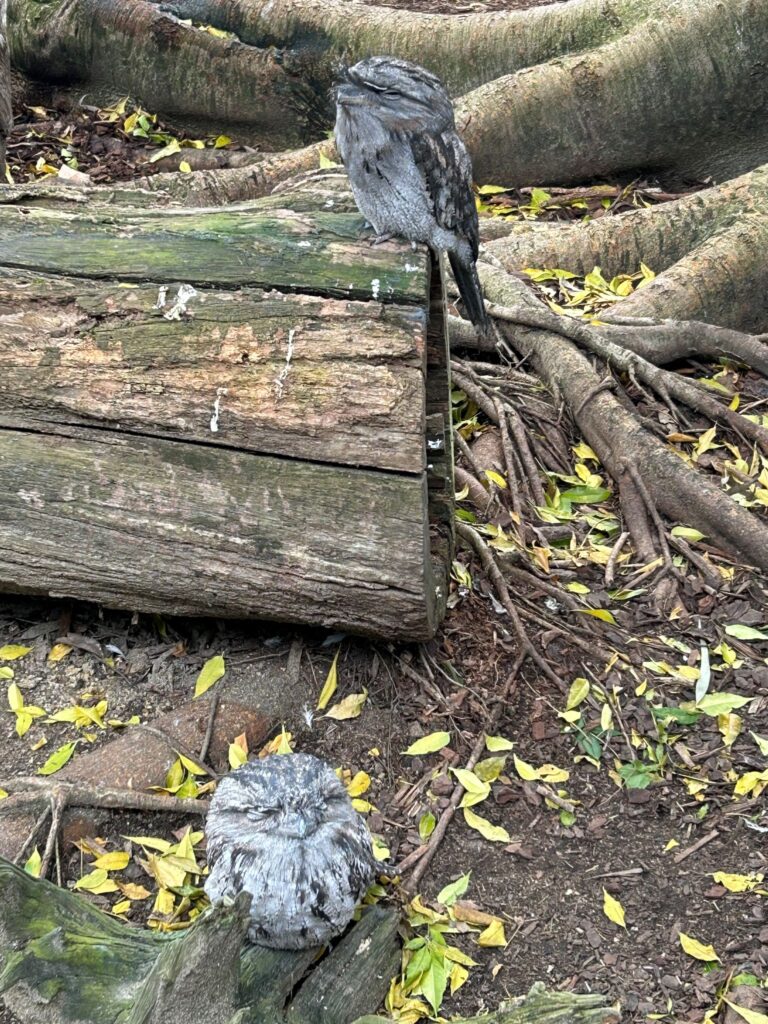Tawny Frogmouth
Learn about this Master of Camouflage
Tawny frogmouths are great, big-headed birds native to Australia that frequently get mistaken for owls due to their nocturnal way of life and similar coloring.
Size and Weight
Tawny Frogmouths are medium-sized birds. They are usually around 35-50 cm long, which is about the size of a small dog. They weigh between 175 to 700 grams, similar to a can of soda.
Appearance
Tawny Frogmouths are known for their unique look! They have large, wide heads with big yellow eyes and a beak that looks like a frog’s mouth, which is how they got their name. Their feathers are mostly grey and brown with streaks, helping them blend into tree bark. When they sit still, they can look just like a broken branch.
Diet
These birds are nocturnal, meaning they hunt at night. Their diet mainly includes insects, spiders, and small invertebrates. Sometimes, they also eat small mammals, frogs, or even other birds. They catch their food by swooping down from a branch and grabbing it with their beak.
Geography
Tawny Frogmouths are found all over Australia, from the dense forests to the dry outback. They’re one of the most widespread birds in the country and can even be seen in suburban areas.
Habitat
These birds are most commonly found in open forests and woodlands, but they’re very adaptable. They can live in various habitats, including parks, gardens, and even on farms. They like to roost (rest) in trees during the day, where they can blend in with their surroundings.
Social Structure
Tawny Frogmouths are usually seen in pairs or small family groups. They are monogamous, meaning they stay with the same partner for life. These birds are very quiet and prefer to keep to themselves, communicating with soft, low sounds.
Breeding
During the breeding season, which is from August to December, Tawny Frogmouths build simple nests made of sticks. Both parents take turns incubating the eggs, usually one or two. The chicks are born with fluffy white feathers and are cared for by both parents until they’re ready to fly.
Threats
One of the main threats to Tawny Frogmouths is habitat loss due to deforestation and urbanization. They are also at risk of being hit by cars, as they often hunt along roadsides at night. Predators like cats, foxes, and large birds of prey also pose a danger to them.
Conservation Status
The Tawny Frogmouth is currently not considered endangered. Their population is stable, and they are classified as “Least Concern” by conservation organizations.
Conservation Efforts
To help protect Tawny Frogmouths, people are working on preserving their natural habitats. This includes planting more native trees and shrubs, creating wildlife corridors, and raising awareness about the dangers of using pesticides, which can poison their food sources. Conservationists also encourage responsible pet ownership to reduce the number of predators that threaten these unique birds.
Tawny Frogmouths are fascinating birds that play an important role in the ecosystem, and with continued efforts, we can ensure they remain a part of Australia’s wildlife for generations to come.
